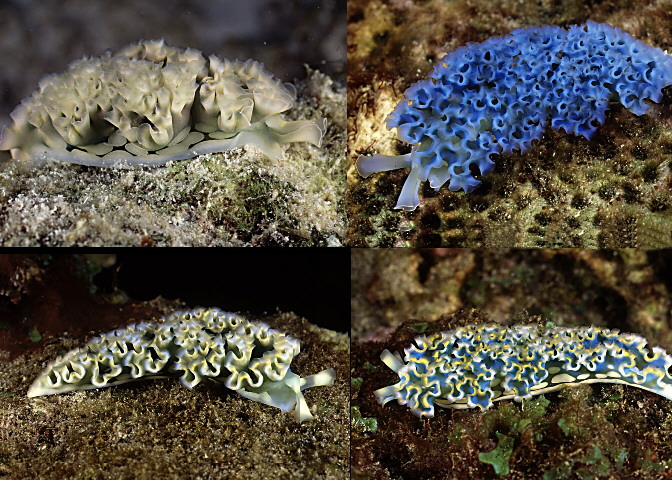 |
Elysia crispata
For an expanded view of the above images, click on the following image links:
| Image | File | Size | Photographer(s) | Description |
|---|---|---|---|---|
 | nudi01.jpg | 122K | Bob and Ceci Brace | Elysia crispata |
| nudi02.jpg | 149K | Bob and Ceci Brace | Elysia crispata | |
| nudi03.jpg | 206K | Bob and Ceci Brace | Elysia crispata | |
| nudi04.jpg | 165K | Bob and Ceci Brace | Elysia crispata |
Elysia crispata (Morch, 1863)
I'm not really sure, but this may be the MOST variably colored opisthobranch in the Caribbean, maybe in the world. It is also one whose name has caused many a sea slug taxonomists to pull out his hair. Let's discuss the name first.
Almost everywhere you look you will see this species referred to as Tridachia crispata. Placement in the genus Elysia was published by Terry Gosliner in 1995. This species and the almost identical Tridachiella diomedea (Bergh, 1894) from the Pacific side of the Central American oceanic divide were both assigned to the genus Elysia due to their close internal anatomical similarities. Gosliner argues that the anatomy was simply too similar to justifiably warrant maintaining two monospecific genera exclusively for them. (The only difference between Tridachiella and Tridachia with Elysia is the degree of convolution of the parapodia. Since species of Elysia can run the full gamut from virtually no convolutions to being highly convoluted, there are no characteristics unique to Tridachia or Tridachiella. Another interesting fact is that it is clear that diomedea and crispata are more closely related to each other than to any other species and that they have diverged from a common ancestor following the closure of the Isthmus of Panama. This is a classic case of speciation following geographical isolation (Comments from Terry Gosliner)). Even the most recent book out on the market - Dan Gotshall's, Sea of Cortez Marine Animals, Second Edition, refers to the Gulf of California species incorrectly as Tridachia.. So folks lets start using the correct name.
Concerning the variation in color, even Marcus and Marcus (1967) show two color examples in the only color plate presented in their timeless monograph. What we see here in Bob and Ceci's gorgeous photos is simply incredible. If these were chromodorids, they would all be considered separate species. How is it that the brilliant blue specimen (upper right photo) is the same beast as the two multi-colored specimens (lower right and left)? Well they are, what more can I say? And how about the subtle light green specimen? I must admit that when I go to my own files and look at those I've photographed, even I have experienced this incredible complexity of color and pattern.
Humann's Reef Creatures Identification guide shows three color variants, which includes one I experienced on every dive while working last summer at the Bay Islands Beach Resort on Roatan Island, Honduras. This red & yellow banded mantle variation was everywhere, always shallow, grazing on the local encrusting turf. Elysias are sacoglossid opisthobranch mollusks and therefore feed on algae, hence their occurrence in shallow, sunlit waters. I have observed them in Belize in only inches of water while in Honduras 10-25 feet seems to be the preferred depth for this species.
Sefton and Webster Caribbean Reef Invertebrates includes the lovely pale blue variant shown above and also in Humann's guide. The color variations most definitely seem to be locally concentrated and are probably related to highly isolated gene pools, a phenomenon seen throughout the animal kingdom in the Caribbean.
Years ago while collecting along the Honduran Barrier Reef in southern Belize we experienced several colors within the same geographical proximity, but in separate micro-habitats. The variation seen out on the open reef (shown in earlier link) differed significantly from that seen in the protected mangroves. I have wondered whether this interesting photograph by Jeff Hamann of a mangrove specimen which we ID'ed back then as E. crispata, really is, or is some other Elysiid species. Aside from the reduction in the ruffled margin of the mantle, the color patternation follows that of E. crispata closely.
Our thanks to Bob and Ceci for bringing these terrific specimens to our
attention. With every new unique photo like these, taxonomists can weave a
tighter understanding of biology of these species.
Gosliner, T.M. 1995. The Genus Thuridilla (Opisthobranchia: Elysiidae) from the Tropical Indo-Pacific, with a Revision of the Phylogeny and Systematics of the Elysiidae. Proc. Cal. Acad. Sci. 49(1):1-54. [Thuridilla carlsoni sp. nov., Thuridilla kathae n.sp., Thuridilla flavomaculata n.sp., Thuridilla hoffae n.sp., Thuridilla albopustulosa n.sp., Thuridilla undula n.sp., Thuridilla neona n.sp., Thuridilla indopacifica n.sp., Thuridilla multimarginata n.sp., Placobranchus, Elysiella, Plattyclaya, Tridachia, Tridachiella, Elysia.][N]
Elysia crispata photos courtesy of Bob and Ceci Brace of San Diego, Calif.

Webmaster's note: Bob is an expert on digital renditions of underwater film art. His contributions in time and effort have been instrumental in making our annual Photo Festival a success. If you need any assistance in this area, don't hesitate to contact Bob!
Send Bob email at BobBrace@ucsd.edu |
Taxonomic information courtesy of:

David W. Behrens
Author:
Pacific Coast Nudibranchs
Send Dave mail at seachalleng@earthlink.net
|
© The Slug Site, Michael D. Miller 1999. All Rights Reserved.
